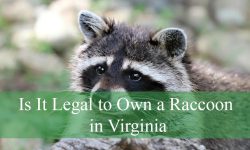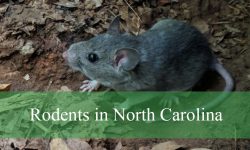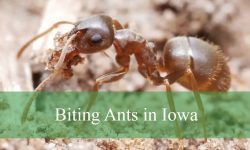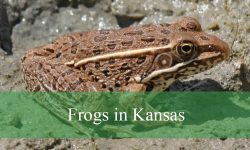The Great Blue Heron, scientifically known as Ardea herodias, is among Florida’s most remarkable wading birds. Its towering height, elegant plumage, and deliberate movements make it a striking presence along rivers, marshes, and coastal estuaries. Despite its apparent calmness, this bird hides many secrets about its behavior, feeding strategies, and interactions with the ecosystem.
In Florida, the Great Blue Heron is both a familiar sight and a symbol of the rich biodiversity found in wetlands and waterways. Observing this bird provides a glimpse into a life shaped by patience, adaptability, and precision.
Physical Characteristics of the Great Blue Heron in Florida
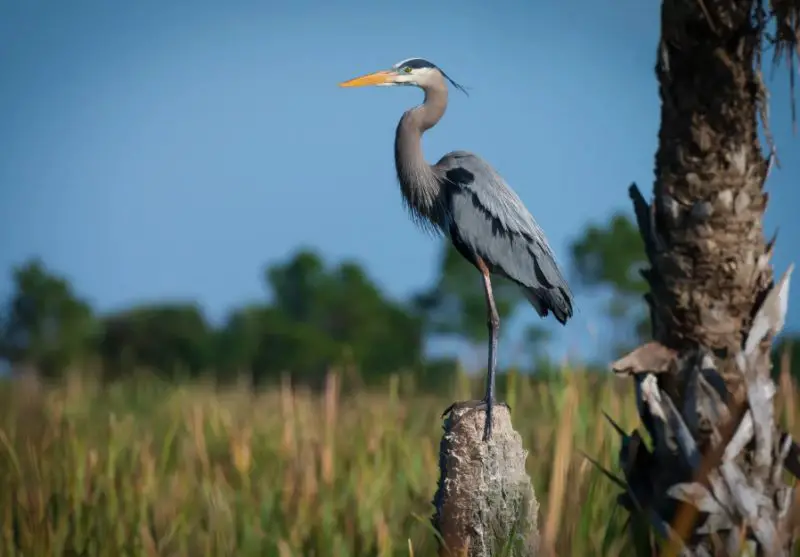
The Great Blue Heron is one of the tallest birds commonly seen in Florida, reaching heights of up to four and a half feet. Its wingspan extends to nearly six and a half feet, giving it a commanding presence in the sky and on water surfaces. The plumage is predominantly bluish-gray, with subtle variations in shade across the wings, back, and underbelly. The face is white with a distinctive black streak running from the eye to the back of the head, forming a sharp contrast against the muted tones of its body.
Juvenile herons in Florida are slightly less vivid, displaying muted gray-blue feathers and lacking the elongated head plumes characteristic of adults. Their legs are long and slender, perfectly adapted for wading through shallow waters, while the dagger-like bill is specialized for quick, precise strikes. One of the most iconic features of the Great Blue Heron is the “S-shaped” curve of its neck, which allows rapid extension and retraction when hunting or in flight. The wings are broad and rounded, enabling a slow and steady wingbeat that conserves energy during long flights over wetlands and coastal marshes.
Behavior and Social Dynamics
Great Blue Herons are often solitary, particularly when foraging, yet they exhibit complex social behaviors during the breeding season. Florida herons establish colonies called heronries, sometimes composed of dozens of nests perched high in trees or mangroves. Within these colonies, courtship behaviors are elaborate and ritualized. Males display aerial maneuvers, stretch their necks, and present sticks to potential mates, signaling both strength and nesting capability.
Despite this temporary social cohesion, herons maintain clear territorial boundaries around feeding areas. They are known to chase intruders away, whether it is other herons or competing wading birds. Outside the breeding season, Florida herons are highly independent, carefully patrolling marshes, riverbanks, and estuaries for abundant prey while avoiding unnecessary conflicts with other birds. Their solitary nature highlights an intriguing balance between independence and cooperative breeding strategies that enhance reproductive success.
Feeding Habits and Hunting Strategies
The hunting behavior of the Great Blue Heron in Florida reflects both patience and remarkable precision. Their diet is highly varied and includes fish, amphibians, small mammals, insects, and crustaceans such as shrimp and crabs. Shallow waters and tidal pools provide optimal hunting grounds, and the heron’s keen eyesight allows it to detect even subtle movements beneath the surface.
Herons employ multiple techniques to capture prey. They may stand motionless for long periods, waiting for fish or amphibians to approach. Alternately, they can move slowly through shallow water, carefully placing each step to avoid creating ripples that could alarm potential prey. When within range, the bird extends its neck in a swift strike, using the sharp bill to grasp or impale its target. In some instances, Great Blue Herons have demonstrated innovative hunting behaviors, such as dropping sticks or feathers onto the water to lure fish, illustrating an unexpected problem-solving ability.
Nesting and Reproductive Behavior
In Florida, Great Blue Herons build nests in tall trees near water, often forming dense colonies that provide safety from predators. Nest construction is a collaborative effort, with males and females gathering sticks, twigs, and other materials to create large, sturdy platforms. These nests are typically reused and expanded each season, reflecting both stability and adaptability in nesting strategies.
The clutch usually contains three to five pale blue eggs, and both parents participate in incubation. The eggs hatch after approximately four weeks, producing altricial chicks that require intensive care. Parents feed their young by regurgitating partially digested food directly into the mouths of the hatchlings. Interestingly, some non-breeding adults assist in caring for the chicks, improving their chances of survival. This form of cooperative behavior reveals an often-overlooked social complexity within heron colonies.
Communication and Visual Signals
Although not highly vocal, Great Blue Herons use a range of sounds and body language for communication. Their calls include a deep croak when alarmed or during territorial disputes, while softer clucking noises may occur during courtship. Body language is even more significant. Raising plumes, stretching the neck, and spreading wings communicate aggression, submission, or mating readiness.
Within colonies, visual signals are crucial. In dense nesting areas, vocalizations can be obscured, so precise gestures and posture become primary methods for coordinating activities, defending territory, and attracting mates. Observing these subtleties offers insight into the sophisticated social interactions of this species.
Migration and Movement Patterns
While most Great Blue Herons in Florida are year-round residents, some northern populations migrate southward during colder months, joining local birds in abundant wetlands and estuaries. Juveniles are often more mobile, moving between different habitats as they establish feeding territories.
Flight behavior is distinctive, with a slow, deliberate wingbeat and a tucked neck forming the characteristic silhouette recognized by birdwatchers. Herons typically fly in the early morning or late afternoon, taking advantage of calm winds and favorable light for navigation. These movements not only aid in feeding efficiency but also provide opportunities for territorial observation and social interaction with other herons and wading birds.
Habitat Preferences and Ecological Role
Florida’s wetlands, estuaries, rivers, and mangrove swamps provide ideal conditions for Great Blue Herons. These environments offer plentiful food, suitable nesting sites, and relative safety from human disturbances and natural predators. Herons play a vital ecological role as apex predators within these systems, helping control populations of fish, amphibians, and small mammals.
Their feeding habits contribute to nutrient cycling, and the presence of herons often encourages biodiversity by creating dynamic interactions among multiple species. Healthy heron populations are indicators of well-preserved wetlands, highlighting the importance of habitat conservation in maintaining Florida’s ecological balance.
Unique and Intriguing Behaviors
The Great Blue Heron exhibits numerous remarkable behaviors that remain largely unknown to casual observers. When sleeping, they often stand on one leg, tucking the other and their neck to conserve body heat. They are also opportunistic feeders, occasionally consuming small reptiles or even carrion if fish and amphibians are scarce.
Roosting is another intriguing aspect. Herons often gather communally in trees or mangroves, providing safety in numbers while maintaining individual alertness. Cultural references frequently depict herons as symbols of patience, grace, and vigilance, reflecting qualities evident in their daily life. Occasionally, herons hunt during twilight hours, taking advantage of favorable water levels and diminished human activity.
Fun Facts and Little-Known Secrets
The Great Blue Heron’s hunting speed is astonishing, with strikes sometimes faster than the human eye can follow. Its specialized vertebrae allow the neck to extend rapidly, an adaptation critical to capturing agile prey. Some individuals demonstrate problem-solving abilities, such as using objects to lure fish, reflecting intelligence not often associated with wading birds.
These birds have existed for over 50 million years, showing remarkable consistency in form and behavior across evolutionary time. Their plumage provides excellent camouflage in marshes and estuaries, rendering them almost invisible to both prey and potential predators. Lifespan in the wild often exceeds 15 years, and protected populations in Florida have been known to reach 20 years or more, emphasizing both resilience and the importance of conservation efforts.
Threats and Conservation Efforts
Despite their adaptability, Great Blue Herons face threats in Florida from habitat loss, pollution, and human disturbance. Urban development encroaches on nesting and feeding areas, while excessive human activity near heronries can disrupt breeding. Conservation measures focus on wetland protection, monitoring population trends, and promoting responsible birdwatching practices. Florida wildlife laws protect these birds, prohibiting disturbance of nests and ensuring their long-term survival.
Effective conservation also highlights the heron’s role as a bioindicator. Declines in heron populations often signal broader environmental challenges, emphasizing the interconnectedness of ecosystems and the importance of protecting wetland habitats.
Observing Great Blue Herons in Florida
Florida offers a wealth of opportunities for observing Great Blue Herons in natural settings. Locations such as Everglades National Park, Merritt Island National Wildlife Refuge, and Corkscrew Swamp Sanctuary provide excellent vantage points. Early mornings and late afternoons are ideal for viewing, as herons are most active during cooler hours when feeding is frequent and prolonged.
Patience is crucial. These birds are highly alert and can take flight at the slightest disturbance. Using binoculars or spotting scopes enhances observation while maintaining a safe distance. Watching the heron’s hunting technique, courtship rituals, and social interactions offers a unique window into a species that is as graceful as it is intelligent.
Conclusion
The Great Blue Heron in Florida embodies elegance, intelligence, and adaptability. Its deliberate hunting, complex social interactions, and intricate nesting behaviors reveal a species finely tuned to its environment. Beyond its striking appearance, the heron plays a crucial ecological role, contributing to the balance of wetland ecosystems. Observing these birds offers not only aesthetic pleasure but also insight into the intricate web of life in Florida’s waterways. Protecting their habitats and respecting their natural behaviors ensures that the Great Blue Heron continues to thrive, captivating future generations with its silent grace and remarkable secrets.
FAQs About the Great Blue Heron in Florida
What Is the Typical Size of a Great Blue Heron in Florida?
Great Blue Herons in Florida are among the tallest wading birds, reaching heights of up to four and a half feet with wingspans approaching six and a half feet. Their long legs, broad wings, and elongated necks give them a commanding presence both in flight and while standing in shallow water. Juveniles are slightly smaller and display muted plumage until they reach full maturity.
Where Can I Most Commonly Spot Great Blue Herons in Florida?
These herons are found throughout Florida, frequenting freshwater marshes, rivers, estuaries, and mangrove swamps. Prime locations include Everglades National Park, Merritt Island National Wildlife Refuge, and Corkscrew Swamp Sanctuary. Early mornings and late afternoons provide the best opportunities to observe their feeding and social behaviors in natural habitats.
What Does the Diet of a Great Blue Heron Include?
Florida’s Great Blue Herons are versatile feeders. Their primary diet consists of fish, but they also consume amphibians, small mammals, crustaceans, and insects. Some herons have even been observed capturing small reptiles or using creative strategies, like dropping objects on the water to lure fish, showcasing their intelligence and adaptability in feeding.
How Do Great Blue Herons Hunt and Catch Prey?
These birds are patient and strategic hunters. They may stand motionless in shallow waters for extended periods, waiting for prey to come within striking distance. Alternatively, they stalk slowly and deliberately, minimizing ripples in the water. Once prey is close, the heron strikes with a rapid extension of its neck and precise use of its sharp bill to secure a catch.
What Are the Breeding and Nesting Habits of Florida Herons?
Great Blue Herons breed in colonies known as heronries, often located in tall trees near water. Both male and female herons contribute to nest building and incubation. Eggs are pale blue, with clutches ranging from three to five. Chicks hatch after around 25 to 30 days and are fed through regurgitation. Occasionally, non-breeding adults assist with feeding and defending the young, highlighting the species’ cooperative behavior.
Do Great Blue Herons Migrate in Florida?
Most herons in Florida are residents year-round. However, some northern populations migrate south during colder months. Juvenile herons may move to new feeding territories before establishing their own ranges. These movements ensure access to abundant food and suitable roosting sites throughout seasonal changes.
How Do Great Blue Herons Communicate?
Herons use a combination of vocalizations and body language. They emit deep croaks when alarmed or during territorial disputes, while softer sounds occur during courtship. Visual signals, such as raising plumes, stretching the neck, and spreading wings, are especially important in dense colonies where vocal communication might be less effective.
What Are Some Unique Behaviors or “Secrets” of the Great Blue Heron?
Great Blue Herons display several intriguing behaviors. They often sleep standing on one leg while tucking their necks to conserve heat. Their diet is highly adaptable, and they sometimes feed at dusk. Roosting communally in trees provides safety from predators. Additionally, their intelligence allows them to use creative hunting strategies, and their plumage offers exceptional camouflage in Florida’s wetlands.
Are Great Blue Herons Threatened in Florida?
Although not currently endangered, these herons face challenges from habitat loss, pollution, and human disturbance. Urban development encroaches on nesting and feeding areas, and excessive disturbance near colonies can affect breeding success. Conservation efforts focus on wetland preservation, monitoring populations, and promoting responsible birdwatching practices.
Why Are Great Blue Herons Important to Florida’s Ecosystem?
As apex predators in wetland environments, Great Blue Herons help control fish, amphibian, and small mammal populations, maintaining ecological balance. Their feeding and roosting behaviors also contribute to nutrient cycling, while their presence supports biodiversity by interacting with a variety of aquatic and semi-aquatic species. Observing herons provides insight into wetland health and environmental changes.

